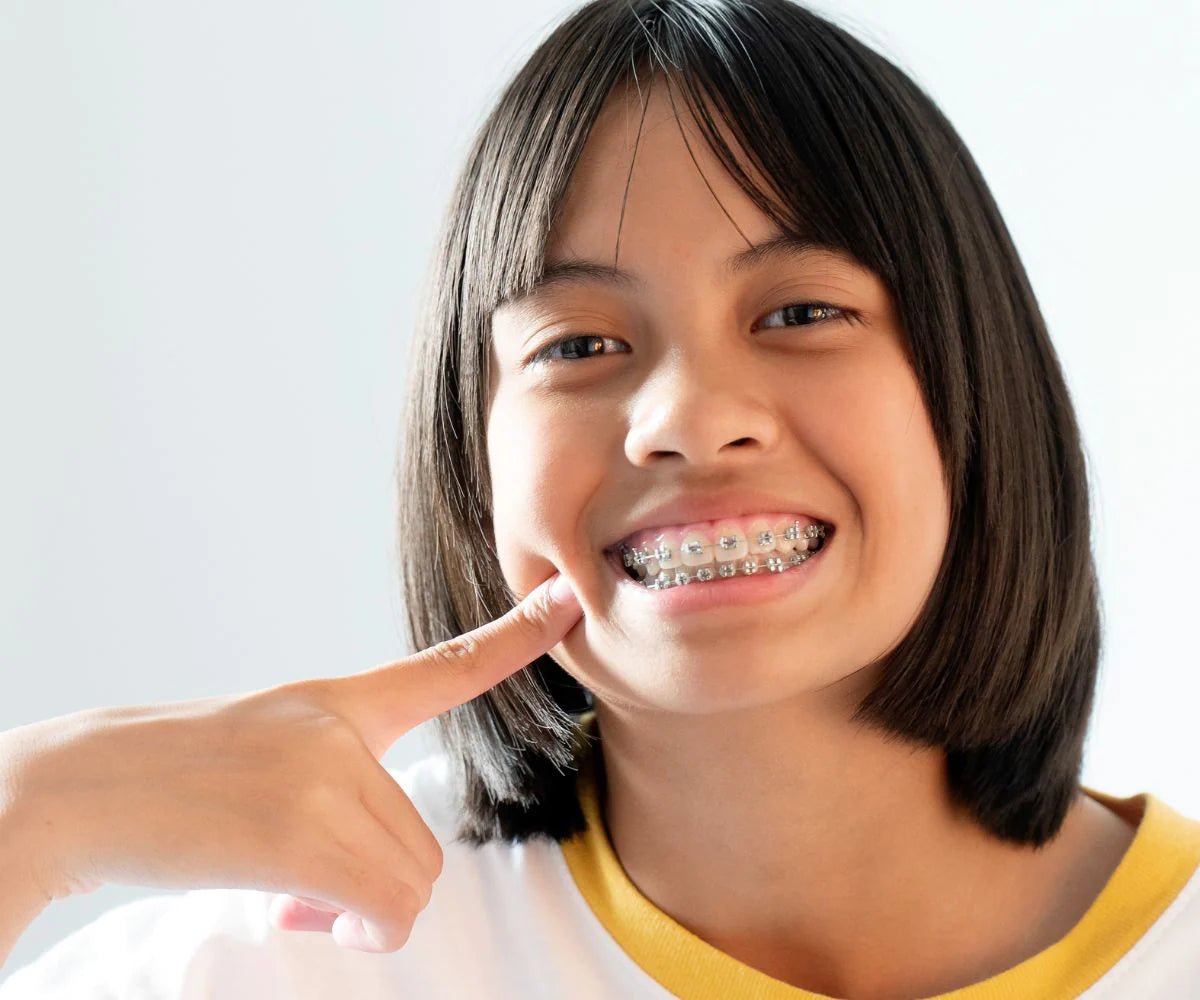The Best Braces Alternatives
for Kids and Teens
Aside from the inconvenience associated with wearing braces, the unpleasing look of metal brackets and archwires can cause a great deal of self-consciousness among young patients.
Based on a study, satisfaction with chewing (comfortability) and teeth appearance influence children and parents the most when wearing braces.
Therefore, finding the best alternative that wouldn't compromise comfortability and aesthetics can give patients, including parents, a breath of fresh air.
The good news is that there are alternatives to braces that offer the best of both worlds.
So, if your child requires orthodontic treatment but refuses to get traditional metal braces, it’s essential that you read this article.
We'll help you make an informed decision by providing an extensive list of braces alternatives for your child.
Throughout the article, we’ll briefly explain each alternative's unique features and benefits while emphasizing the importance of considering a child's specific needs.
But before that, let's start with the most crucial question.
When should I start orthodontic treatment for my child?
There are orthodontic problems that your child's orthodontist might recommend treating after all permanent teeth have erupted, which occurs by the age of 12 to 13.

However, patients with bite irregularities and crowding that could become more serious over time must receive treatment as early as age seven.
On the other hand, the age at which children can have braces depends on their individual dental and skeletal development. Generally, the earliest time for kids to have braces is around 8 to 14.
It's also important to note that not all children will require braces at this age. Again, the timing of orthodontic treatment can vary based on the specific orthodontic issues and the child's growth and development.
Here are some situations in which traditional orthodontic treatments such as braces might not be the most suitable treatment option:
- When the patient suffers from microdontia or when the teeth appear smaller than normal
- If a child has severe untreated dental issues, such as extensive tooth decay, gum disease, or infections
- In cases where the patient has a severely misaligned jaw
- When the patient has conditions affecting bone density, healing, or immune system
There are also circumstances where braces might not necessarily be taken out of the picture and may only require supporting treatment.
For example, an orthodontist may recommend composite bonding for patients with microdontia to build up the undersized teeth.
Dental bonding is a cosmetic procedure that can help enhance and restore the appearance of the patient’s teeth. It uses composite resin, a polymer-based material used in dentistry for aesthetic repairs.
The procedure is pain-free, does not necessitate anesthesia, and, most importantly, does not modify the tooth's natural structure. It's also suitable for all ages.
Before braces are attached, the orthodontist will assess the teeth with composite bonding, its integrity, compatibility, and overall, the patient's orthodontic needs.
The patient must consult with an experienced orthodontist and possibly other dental specialists to determine the most appropriate treatment plan for their case.
Alternatives to braces
There are different braces types, each with advantages and disadvantages. Traditional metal braces are the most common and effective choice among the other braces options.
Traditional metal braces often receive the most attention, not because of their appeal but the awkward look and feel.
Nevertheless, there are other alternatives to braces patients can choose from, with an orthodontist’s approval or recommendation.
A popular and sought-after option are invisible or plastic aligners.
Invisalign or plastic aligners
For patients looking for a comfortable and minimally invasive orthodontic appliance, clear plastic aligners are a perfect choice.
Invisible aligners are custom-fit, removable dental appliances that offer the same benefits as metal braces.
The market for clear aligners can be divided into two main categories: at-home aligners, such as SmileDirectClub, and Invisalign, for in-office aligners.
While there's no "universal best" between the two categories, in-office aligners, specifically Invisalign invisible braces, are the industry's number one recommended brand by dentists and orthodontists.
Their benefits include:
- Virtually invisible
- Easily removable, making cleaning effortless
- More comfortable than traditional braces due to its flexible plastic composition
- Shorter treatment duration compared to conventional methods
- Requires fewer visits to the orthodontist compared to traditional metal braces

Important considerations when choosing Invisalign
While transparent braces, like Invisalign, are considered a leading alternative to traditional braces, they may not be suitable for everyone. Their effectiveness is limited to specific scenarios and conditions.
If you are considering these braces, knowing when they are a better option is essential.
Cost is a significant factor to consider. For example, Invisalign can range from $3,500 to $9,000 in California, making it more expensive than traditional braces.
For age considerations, Invisalign clear aligners are commonly used and recommended to teenagers between 11 and 15, and many adults, typically between 18 and 25, opt for this treatment.
Invisalign may also be also available for younger patients, starting from 6 to 7 years old, with parental assistance often required.
As long as patients have erupted permanent dentition, there is no such thing as "too young or too old" regarding invisible aligners. While this is generally true, there are situations where it may vary.
So, it's still best to consult your kid's orthodontist for proper advice and guidance. You can learn more about Invisalign by reading our comprehensive guide.
What if standard braces are unavoidable?
There would be instances where standard braces may be unavoidable because some orthodontic problems invisible aligner might not fully fix.
For example, teeth may rotate or tilt when your kid's mouth is crowded. If the rotation is more than 20 degrees (for molars) or the tilt is over 45 degrees, Invisalign might struggle to move misaligned teeth to their desired positions.
Other issues plastic aligners wouldn't fully address include:
- Complex dental problems requiring precise control
- Significant vertical misalignment (overbites/underbites)
- Extensive jaw realignment or skeletal adjustments
- Significant gaps between teeth that need closing
- Teeth with specific dental restorations
If your kid suffers from one of the mentioned issues, your orthodontist may recommend the following alternative solutions that work the same as traditional braces but offer more aesthetic advantages.
Ceramic braces
Compared to traditional metal braces, when paired with a white archwire and transparent bands, ceramic braces will virtually look invisible.
Some individuals within professional settings prefer the subtle appearance of ceramic braces because they help maintain a more polished and mature image.

Ultimately, ceramic braces are perfect for kids or teens who might feel too insecure about their appearance with dental appliances.
Because ceramic braces don’t involve using titanium or nickel brackets, they help avoid allergic reactions or gum irritations.
While allergic reactions to metal materials are uncommon in orthodontic patients, they may still exist in patients requiring orthodontic treatment.
In fact, a study found that there might be a 2 to 4% chance of allergic sensitization to titanium in patients undergoing orthodontic treatment. Similarly, patients using braces with nickel material may only have a 12 to 14% chance of developing allergens.
In such rare circumstances, ceramic braces can be the best option.
However, there are cons to choosing ceramic material. First, they are less durable and can be more expensive than metal braces. On average, these braces can cost between $3000 to $8000.
Lingual braces
Unlike traditional braces fixed on the front teeth, lingual braces offer a discreet solution for children seeking orthodontic correction without visible metal components.
There are mainly two types of lingual braces:
Customized
These braces are tailor-made to fit each patient's teeth perfectly. The orthodontist creates them based on precise impressions or digital scans of the patient's teeth. The customized design ensures a more accurate and efficient treatment process.
Standard
They come pre-made in different sizes and shapes to suit a broader range of patients. They are applied to the backside of the teeth just like the customized ones, but some adjustments may be needed during treatment to ensure proper alignment.
Deciding between customized and standard ones depends on a few factors, such as:
- The complexity of the orthodontic needs
- Patient's preferences
- Treatment time frame
- Financial considerations
Customized lingual braces are often the go-to choice when dealing with more complex cases. On the other hand, for less complicated treatments, standard lingual braces can be a suitable option.
Several well-known dental supply manufacturers produce their models of lingual braces. These manufacturers include:
- Incognito (3M)
- Harmony (American Orthodontics)
- SureSmile (OraMetrix)
- Alias (Ormco)
- In-Ovation L (Dentsply GAC)
Because of the technology used in producing these braces and the complexity of their application, they tend to be more costly than traditional metal braces.
Consult an Orthodontist in Culver City
From the subtle charm of the Invisalign treatment to the innovative touch of lingual braces, the choices are as hope-giving and life-changing as the smiles they create.
Remember that finding the right orthodontic partner is crucial in this endeavor. So, why settle for less if you have the best orthodontists at Culver City Dentist United Dental Care?
With a passion for creating joyful and stress-free orthodontic experiences, we have dedicated our lives to bringing out the brightest smiles in every child.
Embrace the magic of modern orthodontics and witness the transformation that will leave your kids grinning from ear to ear!
Contact us today, and let's embark on this incredible adventure together to help your children achieve bright and straight teeth.




 By:
By: 

